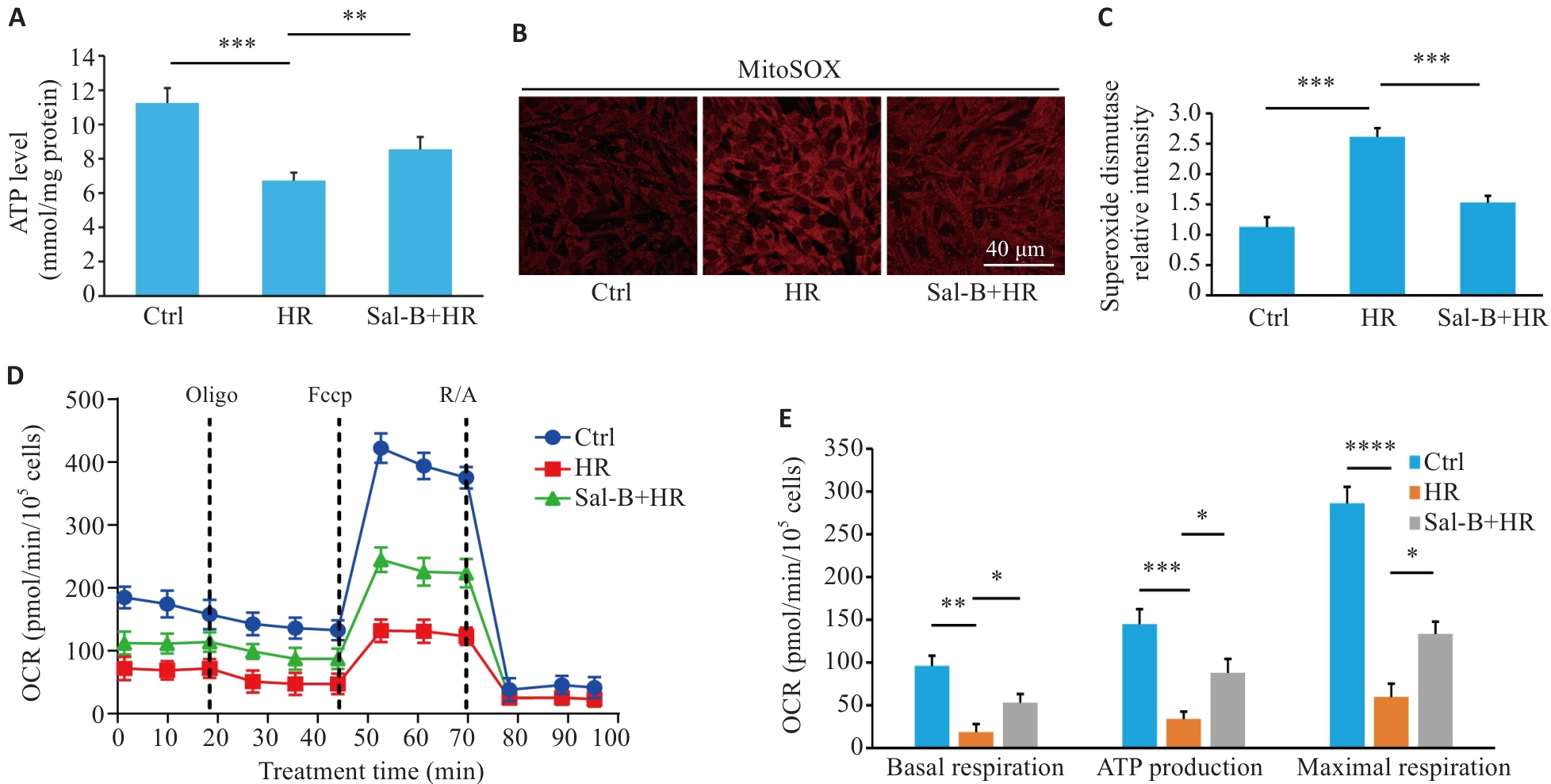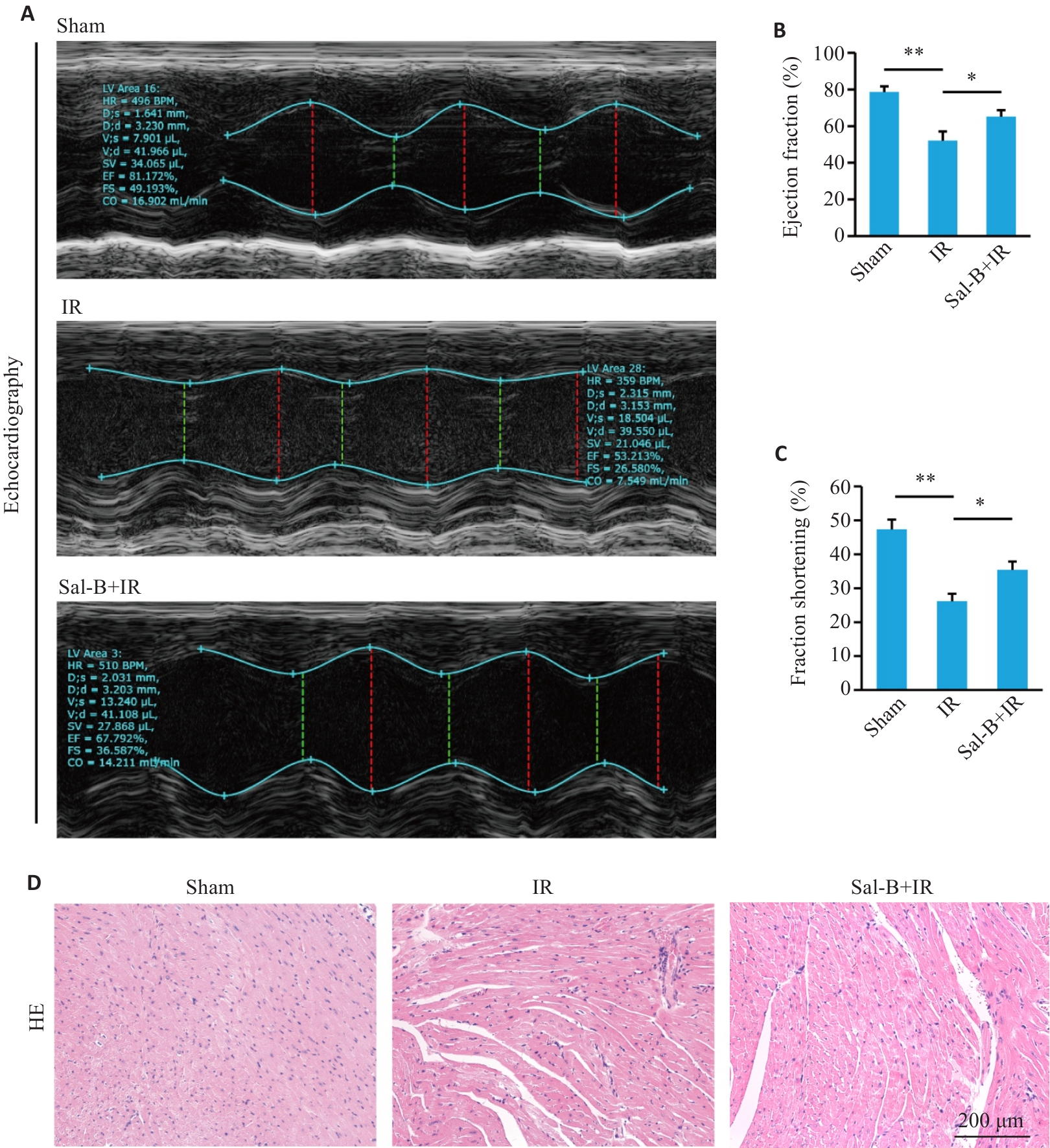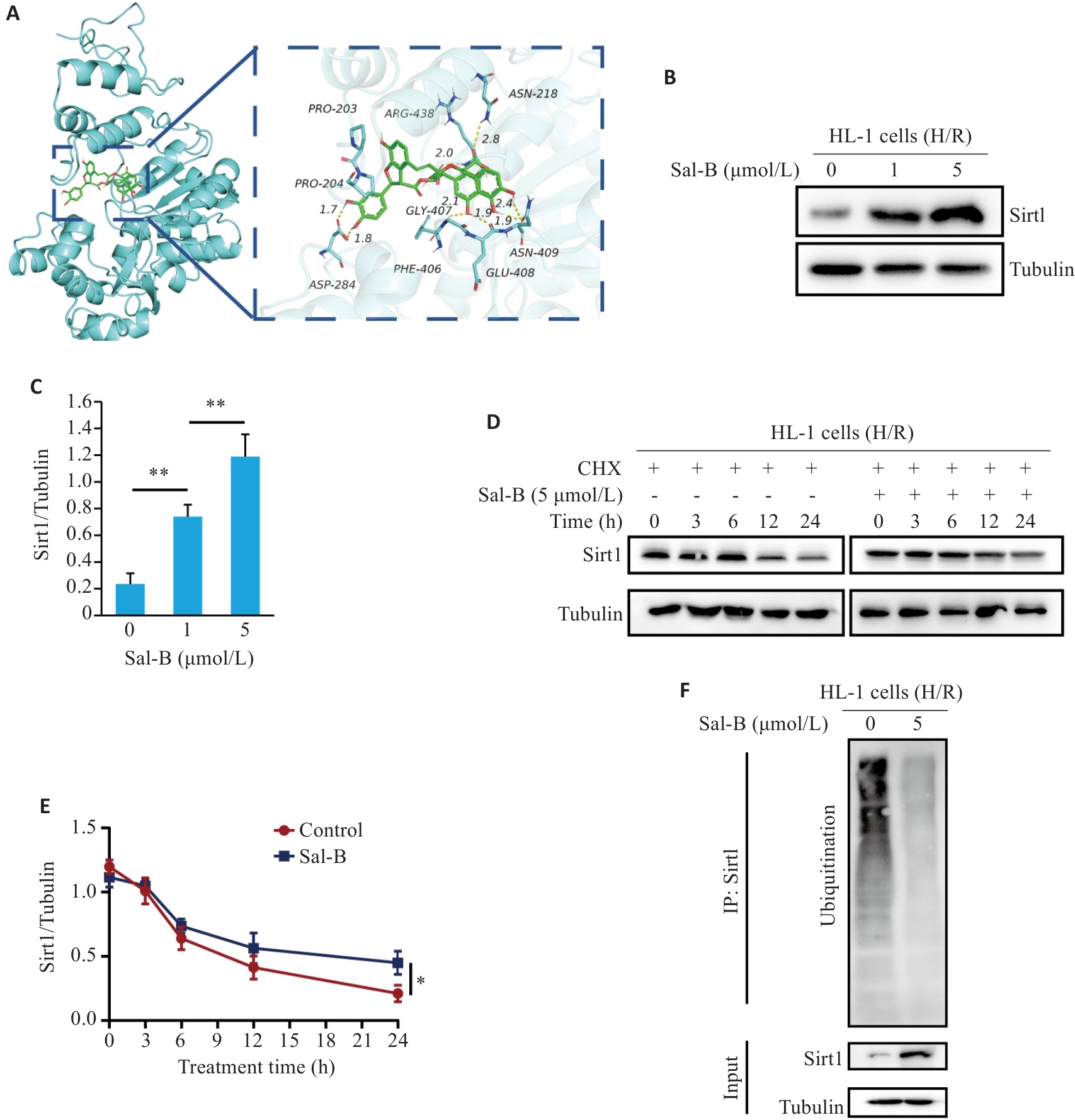Journal of Southern Medical University ›› 2025, Vol. 45 ›› Issue (10): 2062-2070.doi: 10.12122/j.issn.1673-4254.2025.10.02
Simeng LI1,4( ), Jianning CHEN4, Siman SHEN4, Wanglong LIU4, Lili YU1,2,3(
), Jianning CHEN4, Siman SHEN4, Wanglong LIU4, Lili YU1,2,3( ), Liangqing ZHANG1,4(
), Liangqing ZHANG1,4( )
)
Received:2025-05-01
Online:2025-10-20
Published:2025-10-24
Contact:
Lili YU, Liangqing ZHANG
E-mail:3230005101@student.must.edu.mo;llyu@must.edu.mo;zhangliangqing@gdmu.edu.cn
Supported by:Simeng LI, Jianning CHEN, Siman SHEN, Wanglong LIU, Lili YU, Liangqing ZHANG. Salvianolic acid B promotes mitochondrial homeostasis and improves cardiac function in mice with ischemia-reperfusion injury by inhibiting Sirt1 protein degradation[J]. Journal of Southern Medical University, 2025, 45(10): 2062-2070.
Add to citation manager EndNote|Ris|BibTeX
URL: https://www.j-smu.com/EN/10.12122/j.issn.1673-4254.2025.10.02

Fig.1 Sal-B reverses mitochondrial dysfunction in HL-1 cardiomyocytes following hypoxia-reoxygenation (HR) injury. A: ATP production levels in different groups. B, C: Mito-SOX fluorescence staining for detecting superoxide levels in HL-1 cardiomyocytes and statistical results in different groups. D, E: Oxygen consumption rates (OCR) in different groups. *P<0.05, **P<0.01, ***P<0.001, ****P<0.0001.

Fig.2 Sal-B alleviates myocardial I/R injury in mice. A-C: Echocardiographic assessment of cardiac ejection fraction and fractional shortening in mice in different groups. D: HE staining showing myocardial tissue disorganization in the mice from different groups. *P<0.05, **P<0.01.

Fig.3 Sal-B inhibits degradation of Sirt1 protein in HL-1 cardiomyocytes with HR injury. A: Molecular docking diagram of Sal-B and Sirt1. B, C: Western blotting showing the effects of different concentrations of Sal-B on Sirt1 protein expression in the cells. D, E: Western blotting showing the effects of 5 μmol/L Sal-B treatment on Sirt1 protein expression at different time points under the same HR conditions with cycloheximide (CHX) treatment. F: Western blotting showing ubiquitination levels of Sirt1 protein in HL-1 cells treated with 5 μmol/L Sal-B before HR injury. *P<0.05, **P<0.01.

Fig.4 Knockdown of Sirt1 partially reverses homeostatic effects of Sal-B on mitochondrial function in HL-1 cells under HR conditions. A: ATP production levels in different groups. B, C: Mito-SOX fluorescence staining for detecting superoxide levels in HL-1 cardiomyocytes in different groups. D, E: OCR detection in different groups. *P<0.05, **P<0.01, ***P<0.001, ****P<0.0001.

Fig5 Cardiac-specific Sirt1 gene knockout partially abrogates the protective effect of Sal-B on cardiac function in mice with myocardial I/R injury. A-C: Echocardiographic assessment of cardiac ejection fraction and fractional shortening in mice from different groups. D: HE staining of the myocardial tissue in mice from different groups. *P<0.05, **P<0.01.
| [1] | Buja LM. Pathobiology of myocardial ischemia and reperfusion injury: models, modes, molecular mechanisms, modulation, and clinical applications[J]. Cardiol Rev, 2023, 31(5): 252-64. doi:10.1097/crd.0000000000000440 |
| [2] | Crossman DC. The pathophysiology of myocardial ischaemia[J]. Heart, 2004, 90(5): 576-80. doi:10.1136/hrt.2003.029017 |
| [3] | Heusch G. Myocardial ischemia: lack of coronary blood flow or myocardial oxygen supply/demand imbalance[J]? Circ Res, 2016, 119(2): 194-6. doi:10.1161/circresaha.116.308925 |
| [4] | Davidson SM, Ferdinandy P, Andreadou I, et al. Multitarget strategies to reduce myocardial ischemia/reperfusion injury: JACC review topic of the week[J]. J Am Coll Cardiol, 2019, 73(1): 89-99. doi:10.1016/j.jacc.2018.09.086 |
| [5] | Shi M, Huang FF, Deng CP, et al. Bioactivities, biosynthesis and biotechnological production of phenolic acids in Salvia miltiorrhiza [J]. Crit Rev Food Sci Nutr, 2019, 59(6): 953-64. doi:10.1080/10408398.2018.1474170 |
| [6] | Hu SA, Yang ZH, Li L, et al. Salvianolic acid B alleviates liver injury by regulating lactate-mediated histone lactylation in macrophages[J]. Molecules, 2024, 29(1): 236. doi:10.3390/molecules29010236 |
| [7] | Liu CL, Xie LX, Li M, et al. Salvianolic acid B inhibits hydrogen peroxide-induced endothelial cell apoptosis through regulating PI3K/Akt signaling[J]. PLoS One, 2007, 2(12): e1321. doi:10.1371/journal.pone.0001321 |
| [8] | Ho JH, Hong CY. Salvianolic acids: small compounds with multiple mechanisms for cardiovascular protection[J]. J Biomed Sci, 2011, 18(1): 30. doi:10.1186/1423-0127-18-30 |
| [9] | Katary MA, Abdelsayed R, Alhashim A, et al. Salvianolic acid B slows the progression of breast cancer cell growth via enhancement of apoptosis and reduction of oxidative stress, inflammation, and angiogenesis[J]. Int J Mol Sci, 2019, 20(22): 5653. doi:10.3390/ijms20225653 |
| [10] | Pan CS, Lou LX, Huo YQ, et al. Salvianolic acid B and tanshinone IIA attenuate myocardial ischemia injury in mice by NO production through multiple pathways[J]. Ther Adv Cardiovasc Dis, 2011, 5(2): 99-111. doi:10.1177/1753944710396538 |
| [11] | Hu Y, Wang XY, Li QJ, et al. Salvianolic acid B alleviates myocardial ischemic injury by promoting mitophagy and inhibiting activation of the NLRP3 inflammasome[J]. Mol Med Rep, 2020, 22(6): 5199-208. doi:10.3892/mmr.2020.11589 |
| [12] | Yang YH, Sun ZY, Sun XN, et al. Protective effect of salvianolic acid B against myocardial ischemia/reperfusion injury: preclinical systematic evaluation and meta-analysis[J]. Front Pharmacol, 2024, 15: 1452545. doi:10.3389/fphar.2024.1452545 |
| [13] | Mao QP, Shao CY, Zhou HF, et al. Exploring the mechanism of salvianolic acid B against myocardial ischemia-reperfusion injury based on network pharmacology[J]. Pharmaceuticals (Basel), 2024, 17(3): 309. doi:10.3390/ph17030309 |
| [14] | Zhang Q, Liu J, Duan H, et al. Activation of Nrf2/HO-1 signaling: an important molecular mechanism of herbal medicine in the treatment of atherosclerosis via the protection of vascular endothelial cells from oxidative stress[J]. J Adv Res, 2021, 34: 43-63. doi:10.1016/j.jare.2021.06.023 |
| [15] | Joe Y, Zheng M, Kim HJ, et al. Salvianolic acid B exerts vasoprotective effects through the modulation of heme oxygenase-1 and arginase activities[J]. J Pharmacol Exp Ther, 2012, 341(3): 850-8. doi:10.1124/jpet.111.190736 |
| [16] | Chen RS, Zheng AR, Wang YJ, et al. Salvianolic acid B improves mitochondrial dysfunction of septic cardiomyopathy via enhancing ATF5-mediated mitochondrial unfolded protein response[J]. Toxicol Appl Pharmacol, 2024, 491: 117072. doi:10.1016/j.taap.2024.117072 |
| [17] | Michishita E, Park JY, Burneskis JM, et al. Evolutionarily conserved and nonconserved cellular localizations and functions of human SIRT proteins[J]. Mol Biol Cell, 2005, 16(10): 4623-35. doi:10.1091/mbc.e05-01-0033 |
| [18] | Tanno M, Sakamoto J, Miura T, et al. Nucleocytoplasmic shuttling of the NAD+-dependent histone deacetylase SIRT1[J]. J Biol Chem, 2007, 282(9): 6823-32. doi:10.1074/jbc.m609554200 |
| [19] | Vaquero A, Scher MB, Lee DH, et al. SirT2 is a histone deacetylase with preference for histone H4 Lys 16 during mitosis[J]. Genes Dev, 2006, 20(10): 1256-61. doi:10.1101/gad.1412706 |
| [20] | Schwer B, North BJ, Frye RA, et al. The human silent information regulator (Sir)2 homologue hSIRT3 is a mitochondrial nicotinamide adenine dinucleotide-dependent deacetylase[J]. J Cell Biol, 2002, 158(4): 647-57. doi:10.1083/jcb.200205057 |
| [21] | Haigis MC, Mostoslavsky R, Haigis KM, et al. SIRT4 inhibits glutamate dehydrogenase and opposes the effects of calorie restriction in pancreatic beta cells[J]. Cell, 2006, 126(5): 941-54. doi:10.1016/j.cell.2006.06.057 |
| [22] | Nakagawa T, Lomb DJ, Haigis MC, et al. SIRT5 Deacetylates carbamoyl phosphate synthetase 1 and regulates the urea cycle[J]. Cell, 2009, 137(3): 560-70. doi:10.1016/j.cell.2009.02.026 |
| [23] | Mostoslavsky R, Chua KF, Lombard DB, et al. Genomic instability and aging-like phenotype in the absence of mammalian SIRT6[J]. Cell, 2006, 124(2): 315-29. doi:10.1016/j.cell.2005.11.044 |
| [24] | Kiran S, Chatterjee N, Singh S, et al. Intracellular distribution of human SIRT7 and mapping of the nuclear/nucleolar localization signal[J]. FEBS J, 2013, 280(14): 3451-66. doi:10.1111/febs.12346 |
| [25] | Peng F, Liao MR, Jin WK, et al. 2-APQC, a small-molecule activator of Sirtuin-3 (SIRT3), alleviates myocardial hypertrophy and fibrosis by regulating mitochondrial homeostasis[J]. Signal Transduct Target Ther, 2024, 9(1): 133. doi:10.1038/s41392-024-01816-1 |
| [26] | Mao JX, Wang D, Wang D, et al. SIRT5-related desuccinylation modification of AIFM1 protects against compression-induced intervertebral disc degeneration by regulating mitochondrial homeostasis[J]. Exp Mol Med, 2023, 55(1): 253-68. doi:10.1038/s12276-023-00928-y |
| [27] | Teng P, Cui KS, Yao SR, et al. SIRT5-mediated ME2 desuccinylation promotes cancer growth by enhancing mitochondrial respiration[J]. Cell Death Differ, 2024, 31(1): 65-77. doi:10.1038/s41418-023-01240-y |
| [28] | Wei XH, Chen J, Wu XF, et al. Salvianolic acid B alleviated myocardial ischemia-reperfusion injury via modulating SIRT3-mediated crosstalk between mitochondrial ROS and NLRP3[J]. Phytomedicine, 2025, 136: 156260. doi:10.1016/j.phymed.2024.156260 |
| [29] | Niu WH, Wu F, Cao WY, et al. Salvianolic acid B alleviates limb ischemia in mice via promoting SIRT1/PI3K/AKT pathway-mediated M2 macrophage polarization[J]. Evid Based Complement Alternat Med, 2022, 2022: 1112394. doi:10.1155/2022/1112394 |
| [30] | Tang BL. Sirt1 and the mitochondria[J]. Mol Cells, 2016, 39(2): 87-95. doi:10.14348/molcells.2016.2318 |
| [31] | Xu HB, Song XN, Zhang XR, et al. SIRT1 regulates mitochondrial fission to alleviate high altitude hypoxia inducedcardiac dysfunction in rats via the PGC-1α-DRP1/FIS1/MFF pathway[J]. Apoptosis, 2024, 29(9/10): 1663-78. doi:10.1007/s10495-024-01954-5 |
| [32] | Zheng MS, Bai YL, Sun XY, et al. Resveratrol reestablishes mitochondrial quality control in myocardial ischemia/reperfusion injury through Sirt1/Sirt3-Mfn2-parkin-PGC-1α pathway[J]. Molecules, 2022, 27(17): 5545. doi:10.3390/molecules27175545 |
| [33] | Tang W, Guo RN, Hu CY, et al. BMAL1 alleviates myocardial damage in sepsis by activating SIRT1 signaling and promoting mitochondrial autophagy[J]. Int Immunopharmacol, 2024, 133: 112111. doi:10.1016/j.intimp.2024.112111 |
| [34] | Du ZH, Zhou YT, Li QH, et al. SIRT1 ameliorates lamin A/C deficiency-induced cardiac dysfunction by promoting mitochondrial bioenergetics[J]. JACC Basic Transl Sci, 2024, 9(10): 1211-30. doi:10.1016/j.jacbts.2024.05.011 |
| [35] | Ding XQ, Zhu CY, Wang WH, et al. SIRT1 is a regulator of autophagy: Implications for the progression and treatment of myocardial ischemia-reperfusion[J]. Pharmacol Res, 2024, 199: 106957. doi:10.1016/j.phrs.2023.106957 |
| [1] | Jialie JIN, Fei WANG, Liya ZHU, Xiaojing ZHAO, Jinxin WANG, Chao ZHU, Rongxi YANG. Association between MLPH gene hypermethylation in peripheral blood and coronary heart disease [J]. Journal of Southern Medical University, 2025, 45(9): 1859-1866. |
| [2] | Lu ZHANG, Huanzhang DING, Haoran XU, Ke CHEN, Bowen XU, Qinjun YANG, Di WU, Jiabing TONG, Zegeng LI. Shenqi Buzhong Formula ameliorates mitochondrial dysfunction in a rat model of chronic obstructive pulmonary disease by activating the AMPK/SIRT1/PGC-1α pathway [J]. Journal of Southern Medical University, 2025, 45(5): 969-976. |
| [3] | Fenlan BIAN, Shiyao NI, Peng ZHAO, Maonanxing QI, Bi TANG, Hongju WANG, Pinfang KANG, Jinjun LIU. Asiaticoside alleviates myocardial ischemia-reperfusion injury in rats by inhibiting NLRP3 inflammasome-mediated pyroptosis [J]. Journal of Southern Medical University, 2025, 45(5): 977-985. |
| [4] | Xiupeng LONG, Shun TAO, Shen YANG, Suyun LI, Libing RAO, Li LI, Zhe ZHANG. Quercetin improves heart failure by inhibiting cardiomyocyte apoptosis via suppressing the MAPK signaling pathway [J]. Journal of Southern Medical University, 2025, 45(1): 187-196. |
| [5] | Zhiliang CHEN, Yonggang YANG, Xia HUANG, Yan CHENG, Yuan QU, Qiqi HENG, Yujia FU, Kewei LI, Ning GU. Differential expressions of exosomal miRNAs in patients with chronic heart failure and hyperuricemia: diagnostic values of miR-27a-5p and miR-139-3p [J]. Journal of Southern Medical University, 2025, 45(1): 43-51. |
| [6] | Hongzhe WANG, Haitang XIE, Wulan XU, Ming Li. Urolithin A alleviates respiratory syncytial virus-induced lung infection in neonatal mice by activating miR-136-mediated Sirt1 signaling [J]. Journal of Southern Medical University, 2024, 44(7): 1370-1381. |
| [7] | Zhijun REN, Jianxin DIAO, Yiting WANG. Xionggui Decoction alleviates heart failure in mice with myocardial infarction by inhibiting oxidative stress-induced cardiomyocyte apoptosis [J]. Journal of Southern Medical University, 2024, 44(7): 1416-1424. |
| [8] | Jiaqi HU, Jianxing ZHANG. High-flow nasal oxygen versus conventional oxygen therapy during cesarean section under neuraxial anesthesia in pregnant women with heart disease: a randomized controlled trial [J]. Journal of Southern Medical University, 2024, 44(6): 1040-1047. |
| [9] | Caiyu SHEN, Shuai WANG, Ruiying ZHOU, Yuhe WANG, Qin GAO, Xingzhi CHEN, Shu YANG. Prediction of risk of in-hospital death in patients with chronic heart failure complicated by lung infections using interpretable machine learning [J]. Journal of Southern Medical University, 2024, 44(6): 1141-1148. |
| [10] | HU Sigan, CHENG Zengwei, LI Min, GAO Shiyi, GAO Dasheng, KANG Pinfang. Correlation between insulin resistance and coronary collateral circulation in patients with chronic total coronary occlusion [J]. Journal of Southern Medical University, 2024, 44(4): 780-786. |
| [11] | WANG Shuying, JIANG Xinzhu, ZHAO Bo, DONG He. Semiparametric analysis of nonparametric proportional hazards models with mixed dependent censored data [J]. Journal of Southern Medical University, 2024, 44(4): 689-696. |
| [12] | ZHOU Fengmin, GUO Yanju, CHEN Ning. Exercise promotes irisin expression to ameliorate renal injury in type 2 diabetic rats [J]. Journal of Southern Medical University, 2024, 44(4): 675-681. |
| [13] | CHEN Guodong, LUO Suxin. Colchicine alleviates myocardial ischemia-reperfusion injury in mice by activating AMPK [J]. Journal of Southern Medical University, 2024, 44(2): 226-235. |
| [14] | WEI Ting, DING Yangyang, ZHANG Jiajia, LI Jinlong, ZHANG Heng, KANG Pinfang, ZHANG Ningru. Correlation of serum ferredoxin 1 and lipoic acid levels with severity of coronary artery disease [J]. Journal of Southern Medical University, 2024, 44(2): 308-316. |
| [15] | Lei WANG, Fenlan BIAN, Feiyang MA, Shu FANG, Zihan LING, Mengran LIU, Hongyan SUN, Chengwen FU, Shiyao NI, Xiaoyang ZHAO, Xinru FENG, Zhengyu SUN, Guoqing LU, Pinfang KANG, Shili WU. Activation of ALDH2 alleviates hypoxic pulmonary hypertension in mice by upregulating the SIRT1/PGC-1α signaling pathway [J]. Journal of Southern Medical University, 2024, 44(10): 1955-1964. |
| Viewed | ||||||
|
Full text |
|
|||||
|
Abstract |
|
|||||